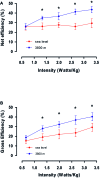Aerobic Capacity, Lactate Concentration, and Work Assessment During Maximum Exercise at Sea Level and High Altitude in Miners Exposed to Chronic Intermittent Hypobaric Hypoxia (3,800 m)
- PMID: 31555155
- PMCID: PMC6742696
- DOI: 10.3389/fphys.2019.01149
Aerobic Capacity, Lactate Concentration, and Work Assessment During Maximum Exercise at Sea Level and High Altitude in Miners Exposed to Chronic Intermittent Hypobaric Hypoxia (3,800 m)
Abstract
We previously showed that arterial oxygen content during maximum exercise remains constant at high altitude (HA) in miners exposed to chronic intermittent hypobaric hypoxia (CIHH). Nevertheless, information about VO2, lactate concentration [Lac], and work efficiency are absent in this CIHH miner population. Our aim was to determine aerobic capacity, [Lac], and work efficiency at sea level (SL) and HA during maximum exercise in miners acclimatized to CIHH at 3,800 m. Eight volunteer miners acclimatized to CIHH at HA (> 4 years) performed an exercise test at SL and HA. The test was performed on the 4th day at HA or SL and consisted of three phases: Rest (5 min); Exercise test, where the load was increased by 50 W every 3 min until exhaustion; and a Recovery period of 30 min. During the procedure VO2, transcutaneous arterial saturation (SpO2, %), and HR (bpm) were assessed at each step by a pulse oximeter and venous blood samples were taken to measure [Lac] and hemoglobin concentration. No differences in VO2 and [Lac] in SL vs. HA were observed in this CIHH miner population. By contrast, a higher HR and lower SpO2 were observed at SL compared with HA. During maximum exercise, a reduction in VO2 and [Lac] was observed without differences in intensity (W) and HR. A decrease in [Lac] was observed at maximum effort (250 W) and recovery at HA vs. SL. These findings are related to an increased work efficiency assessment such as gross and net efficiency. This study is the first to show that miners exposed to CIHH maintain their work capacity (intensity) with a fall in oxygen consumption and a decrease in plasmatic lactate concentration at maximal effort at HA. These findings indicate that work efficiency at HA is enhanced.
Keywords: aerobic capacity; chronic hypobaric intermittent hypoxia; lactate concentration; miners workers; work assessment.
Figures




References
LinkOut - more resources
Full Text Sources

